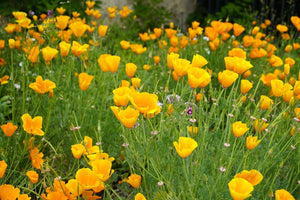Why Growing Tussock Bellflower (Campanula) from Seed is Easier Than You Think
BellflowerTussock Bellflower, also known as Carpathian Harebell or Campanula carpatica, is an excellent choice for borders, containers, rock gardens, and any place you want a beautiful and reliable blooming perennial. We’ll explain how to start growing bellflowers from seed, no matter your location.

This beautiful and delicate-looking perennial is relatively hardy in many locations. Campanula carpatica is named for the Carpathian Mountains, where it is a well-known native flower. Tussock Bellflower comes from the Campanula genus, which has around 300 species. Also called Carpathian Bellflower for its bell-shaped flowers that turn up towards the sun, this easy-care plant will make a striking display in your flower garden.
Tussock Bellflower grows in mounds about 12 inches high and 12 inches wide. One to two-inch flowers grow above the mound of green foliage to create a colorful display.
Tussock Bellflower is a popular heirloom variety of Campanula carpatica. This delicate-looking flower is hardy and will add charm to your garden with its profusion of purple-blue, bell-shaped flowers—a natural magnet for hummingbirds, bees, and butterflies. The compact, mounding habit makes it ideal for rock gardens, borders, or containers.
Growing Tussock Bellflower - Campanula carpatica from Seed
Tussock Bellflower seeds can be sown outdoors or started inside. The timing and method of planting are essential to ensure successful seed germination.

Tussock Bellflower Seed Germination Tips
Cold stratification for 4 weeks
Plant seeds ⅛” deep
Need light to germinate
14 - 21 days to germination
Seeds can be sown in spring or fall
Bellflower seeds need cold stratification to germinate. Cold stratification signals to the seeds when it’s time to wake up. The seeds need about 4 weeks of cold temperatures before they will sprout. If you plant seeds outside in fall or early winter, they will have a natural cold period and then be ready to germinate when the soil warms up in spring.
You can also cold-stratify seeds by placing them in the fridge for 4 weeks. Cold-stratified seeds can then be planted outside or indoors.
Start bellflower seeds indoors 8-10 weeks before the last spring frost. Cold stratify the seeds and then plant them ⅛” deep or press them into the soil and lightly cover them. Soil temperature should be between 60-70ºF. Bellflower seeds need light to germinate, so use a grow light indoors. A humidity dome can help keep the seeds moist until they germinate in 14 to 21 days.

Caring for Campanula carpatica - Bellflowers
Bellflowers are known for being easy to care for perennials. The beautiful bell-shaped flowers bloom in mid-summer and attract hummingbirds, bees, and butterflies.
Bellflower seedlings started indoors should be hardened off before transplanting outdoors. Wait until the seedlings are 3 to 4 inches tall and all danger of frost has passed. Then, slowly transition the plants by placing them outside for one hour in early morning sun. Increase their outdoor exposure by one hour each day. When they are up to 6 or 8 hours a day of sunlight, they will be ready for transplanting.
Plant bellflower seedlings 12 to 18 inches apart. This will give them room to grow and allow for their natural mounding shape.
Sun
Tussock Bellflower can thrive in full sun to partial shade. Like most flowering plants, more sun will result in more and bigger blooms. At least 6 hours of direct sunlight will ensure maximum blooming. In hot climates, afternoon shade will be appreciated.

Soil
Water
Fertilizer
Harvesting
Tussock Bellflowers can be used as a cut flower. Cut stems right as the blossoms are beginning to bloom.
Because of the abundance of flowers, you will want to remove blooms as soon as they start to fade. This will keep the plants looking tidy and encourage more blooms.
Overwintering
Campanula carpatica is winter hardy to zone 3. You can cover the plants with mulch in the winter. After a few years, you can divide clumps in early spring or fall.

Companion Plants for Campanula
When planning your location for growing Tussock Bellflower (Campanula carpatica), you should consider your color scheme as well as the growing environment. It’s the perfect flower for a cottage garden, where it will grow slowly and return year after year. It is also a popular choice along borders because of its profusion of flowers and low height. Plant it along your garden pathway and add taller flowers like echinacea behind it. You can also grow bellflowers with other mountain plants like Columbine and Alpine Strawberries.
Growing Tussock Bellflower in Containers
Tussock Bellflower is an excellent species for growing in containers. Its mounding shape looks nice and grows slowly enough not to outgrow its pot.
To grow bellflowers in a pot, select a large enough container with good drainage holes. Water often to keep the soil moist. Fertilize with a slow-release, balanced fertilizer every few weeks throughout the growing season.

Bellflower FAQs
Is Tussock Bellflower invasive?
While some varieties of Campanula are aggressive spreaders, the Tussock Bellflower is not. It spreads so slowly that it isn’t considered invasive and can be divided every few years.
Is Tussock Bellflower a perennial?
Tussock Bellflower is a hardy perennial that can be grown in zones 3 to 9.
Does Carpathian Bellflower spread?
Carpathian Bellflower, also known as Tussock Bellflower, spreads slowly through rhizomes. It is easy to maintain by dividing and cutting back as needed.
Should I cut back Bellflower?
Cutting back Bellfower is a great way to keep it looking nice and will also encourage more flower production.
Whether you call it Campanula carpatica, Carpathian Harebell, or Carpathian Bellflower, Tussock Bellflower is an easy-to-grow perennial that looks beautiful in any garden. Add it wherever you want to enjoy the sight of the delicate bells that attract hummingbirds and butterflies. With these growing tips, you can successfully sow bellflowers from seed to enjoy their blossoms for years.
Popular Posts
-

Sweet and Juicy Heirloom Watermelon Varieties to Grow
-

How to Grow Poppies from Seed for Your Own Superbloom!





Leave a comment